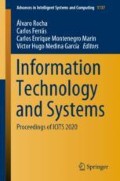Abstract
Classifiers are tools widely used nowadays to process data and obtain prediction models that are trained through supervised learning techniques; there is a wide variety of sensors that acquire the data to be processed, such as the voltammetric electronic tongue, as a device employed to analyze food compounds. This paper presents a normal and decaffeinated coffee beverage classifier using a Support Vector Machine with a linear separation function, detailing the classification function and the model optimization method; to train the model, the data measured by 4 electrodes of a voltammetric tongue that is excited by a predetermined sequence of positive pulses is used. In addition, the results graphically show the measurements obtained, the support vectors and the evaluation data, the values of the classifier parameters are also presented. Finally, the conclusions establish an acceptable error in the classification of coffee drinks according to caffeine presence at the sample analyzed.
Access this chapter
Tax calculation will be finalised at checkout
Purchases are for personal use only
References
Salah, K., Rehman, M.H.U., Nizamuddin, N., Al-Fuqaha, A.: Blockchain for AI: review and open research challenges. IEEE Access (2019). https://doi.org/10.1109/ACCESS.2018.2890507
Lu, H., Li, Y., Chen, M., Kim, H., Serikawa, S.: Brain intelligence: go beyond artificial intelligence. Mob. Networks Appl. (2018). https://doi.org/10.1007/s11036-017-0932-8
Çaliş, B., Bulkan, S.: A research survey: review of AI solution strategies of job shop scheduling problem. J. Intell. Manuf. (2015). https://doi.org/10.1007/s10845-013-0837-8
Nickel, M., Murphy, K., Tresp, V., Gabrilovich, E.: A review of relational machine learning for knowledge graphs (2016). https://doi.org/10.1109/JPROC.2015.2483592
Jara Estupiñan, J., Giral, D., Martínez Santa, F.: Implementación de algoritmos basados en máquinas de soporte vectorial (SVM) para sistemas eléctricos: revisión de tema. Rev. Tecnura. 20, 149–170 (2016). https://doi.org/10.14483/udistrital.jour.tecnura.2016.2.a11
Ghahramani, Z.: Probabilistic machine learning and artificial intelligence (2015). https://doi.org/10.1038/nature14541
Conneau, A., Kiela, D., Schwenk, H., Barrault, L., Bordes, A.: Supervised learning of universal sentence representations from natural language inference data (2018). https://doi.org/10.18653/v1/d17-1070
Zendehboudi, A., Baseer, M.A., Saidur, R.: Application of support vector machine models for forecasting solar and wind energy resources: a review (2018). https://doi.org/10.1016/j.jclepro.2018.07.164
Yang, D., Liu, Y., Li, S., Li, X., Ma, L.: Gear fault diagnosis based on support vector machine optimized by artificial bee colony algorithm. Mech. Mach. Theory (2015). https://doi.org/10.1016/j.mechmachtheory.2015.03.013
He, H., Kong, F., Tan, J.: DietCam: multiview food recognition using a multikernel SVM. IEEE J. Biomed. Health Inform. (2016). https://doi.org/10.1109/JBHI.2015.2419251
Guevara, C., Sanchez-Gordon, S., Arias-Flores, H., Varela-Aldás, J., Castillo-Salazar, D., Borja, M., Fierro-Saltos, W., Rivera, R., Hidalgo-Guijarro, J., Yandún-Velasteguí, M.: Detection of student behavior profiles applying neural networks and decision trees. In: Advances in Intelligent Systems and Computing, pp. 591–597 (2020). https://doi.org/10.1007/978-3-030-27928-8_90
Fuentes, E., Alcañiz, M., Contat, L., Baldeón, E.O., Barat, J.M., Grau, R.: Influence of potential pulses amplitude sequence in a voltammetric electronic tongue (VET) applied to assess antioxidant capacity in aliso. Food Chem. (2017). https://doi.org/10.1016/j.foodchem.2016.12.076
Ciocca, G., Napoletano, P., Schettini, R.: Food recognition: a new dataset, experiments, and results. IEEE J. Biomed. Health Inform. (2017). https://doi.org/10.1109/JBHI.2016.2636441
Loutfi, A., Coradeschi, S., Mani, G.K., Shankar, P., Rayappan, J.B.B.: Electronic noses for food quality: a review (2015). https://doi.org/10.1016/j.jfoodeng.2014.07.019
Arrieta, Á.A., Rodríguez-Méndez, M.L., De Saja, J.A.: Aplicación de una lengua electrónica voltamétrica para la clasificación de vinos y estudio de correlación con la caracterización química y sensorial. Quim. Nova 33(4), 787–793 (2010)
Gamboa, A.A., Cáceres, P.A., Lamos, H., Zárate, D.A., Puentes, D.E.: Predictive model for cocoa yield in Santander using Supervised Machine Learning. In: 2019 22nd Symposium on Image, Signal Processing and Artificial Vision, STSIVA 2019 - Conference Proceedings (2019). https://doi.org/10.1109/STSIVA.2019.8730258
Chen, M.Y., Yang, Y.H., Ho, C.J., Wang, S.H., Liu, S.M., Chang, E., Yeh, C.H., Ouhyoung, M.: Automatic Chinese food identification and quantity estimation. In: SIGGRAPH Asia 2012 Technical Briefs, SA 2012 (2012). https://doi.org/10.1145/2407746.2407775
Rodrigues, D.R., de Oliveira, D.S.M., Pontes, M.J.C., Lemos, S.G.: Voltammetric e-tongue based on a single sensor and variable selection for the classification of teas. Food Anal. Methods (2018). https://doi.org/10.1007/s12161-018-1162-9
de Morais, T.C.B., Rodrigues, D.R., de Carvalho Polari Souto, U.T., Lemos, S.G.: A simple voltammetric electronic tongue for the analysis of coffee adulterations. Food Chem. (2019). https://doi.org/10.1016/j.foodchem.2018.04.136
Peris, M., Escuder-Gilabert, L.: Electronic noses and tongues to assess food authenticity and adulteration (2016). https://doi.org/10.1016/j.tifs.2016.10.014
Alcañiz Fillol, M.: Diseño de un sistema de lengua electrónica basado en técnicas electroquímicas voltamétricas y su aplicación en el ámbito agroalimentario, p. 295 (2011)
Cristianini, N., Shawe-Taylor, J.: An Introduction to Support Vector Machines and Other Kernel-based Learning Methods. Cambridge University Press (2013). https://doi.org/10.1017/CBO9780511801389
Author information
Authors and Affiliations
Corresponding authors
Editor information
Editors and Affiliations
Rights and permissions
Copyright information
© 2020 Springer Nature Switzerland AG
About this paper
Cite this paper
Varela-Aldás, J., Fuentes, E.M., Buele, J., Meló, R.G., Barat, J.M., Alcañiz, M. (2020). Support Vector Machine as Tool for Classifying Coffee Beverages. In: Rocha, Á., Ferrás, C., Montenegro Marin, C., Medina García, V. (eds) Information Technology and Systems. ICITS 2020. Advances in Intelligent Systems and Computing, vol 1137. Springer, Cham. https://doi.org/10.1007/978-3-030-40690-5_27
Download citation
DOI: https://doi.org/10.1007/978-3-030-40690-5_27
Published:
Publisher Name: Springer, Cham
Print ISBN: 978-3-030-40689-9
Online ISBN: 978-3-030-40690-5
eBook Packages: Intelligent Technologies and RoboticsIntelligent Technologies and Robotics (R0)

